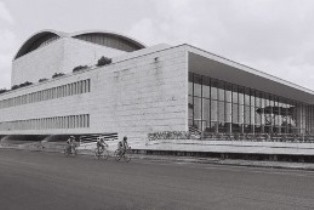
WTI Magazine #9 2013 Dec, 13
Author : Enrico De Iulis Translation by: Alessandra Bitetti
I want to start my column by immediately admitting that to me Adalberto Libera represents the Italian Rationalism. In his pure geometric forms, in his space development solutions with the alternation of horizontal and vertical elements, solids and voids, the preference of white as the color of the surface on which mainly stand out the juxtaposition of other geometries and other materials, he's certainly the most rigorous. And he's the architect who was able to cast the rationalist concept without compromise.
Adalberto Libera was born in 1903 in Austro -Hungarian Tyrol, just before it would become the theater of heavy fighting during the First World War. For this reason, in 1914 he moved to Parma with his family, just before the beginning of the war. In the '20s, in Italy, there was only one Architecture Department, in Rome, plus only two sections in the polytechnics of Milan and Turin. He moved to Rome to follow the courses in the faculty and there he met most of the protagonists who, with him, will contribute to give a new idea of Italian architecture, to demolish the traditional forms of institutional and residential buildings, creating new images, new spaces and urban stainless realities.
Even today, the rationalist buildings created in the years between 1926 and 1950 show a modernity in line with the times, imposing the same solemn geometry to the space around them.
Libera is a master in creating buildings with pure spaces, forms uncontaminated by ornaments or decorations: everything is reduced to pure geometry, which becomes a monolithic, strong, clear and substantial beauty.
In the private buildings there are balconies and projecting roofs that liven up the central block, creating variations in mathematical circles on planes and polygons that change the number of their sides, varying the evolution of the facades. In the institutional spaces the size grows, making sure that the construction succeeds in squaring even the air around it, to compact and shape it in a Euclidean method. The Palazzo dei Congressi dell'Eur in Rome is a perfect example of his design; when the sky is clear, and it is not uncommon in the Italian capital, it seems to be perfectly cut out and stuck on the pure form of the building.
In his ideas, that can be found in the Post Office building in Via Marmorata in Rome, you can recognize all the best rationalist thought, reunited in one single building: the polyhedral bodies fit perfectly together symmetrically, but adopting a trend varied dictated not only by the diversity of their shapes, but also by the rhythmicity of their heights. The very wide use of glass to create a vacuum, near to huge walls of white marble, requires an innovative lightness to the construction for buildings without any external decoration . The decoration is entrusted once again to geometric elements which vary the two-dimensional plane of the facades, turning the lozenge rectangle that becomes the window, or the line in front of the oval entrance that becomes a very stylized porch.
Even inside, the purity of locations creates an airy place that in 1930 had to look like from out of this world. The effect of the construction of these kind of buildings in the historic centers of the Renaissance, Baroque and medieval cities has been disruptive, much criticized and much appreciated. Anyway, in less than 50 years the rationalist style, just like the ones we have just mentioned, was able to earn such a big recognition to be considered the new, and perhaps last, "truly" Italian architectural style.




